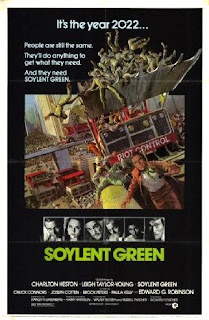Soylent Green

The last of the "Charlton Heston Dystopia Trilogy" was Soylent Green, released in 1973, directed by Richard Fleischer and adapted from a novel by Harry Harrison. It was set in 2022, and was based on the Mathusian laws that population growth would outpace the growth of resources. We see a New York City with a population of 40 million, with fresh food a rarity only for the rich, and the destitute sleeping like sardines in stairwells and alleys.
Heston plays Thorn, a cop, who is lucky because unemployment is at fifty percent. He shares digs with his researcher, played by Edward G. Robinson (it what would be his last role) who is constantly talking about the glories of the old days. He waxes rhapsodic about foods from his youth, while all the proletariat eats is wafers of various colors provided by a super-large corporation. The newest one is called Soylent Green, which is supposedly made out of plankton.
A member of the board of Soylent corporation is murdered, and Heston investigates. First, though, he helps himself to many luxuries from the dead man's home, and also ends up helping himself to his "furniture," which is a word used for a prostitute who comes with the apartment (Leigh Taylor-Young). In the tradition of noir, Heston's policeman is extremely amoral, but over the course of the film he comes to realize some truths, foremost the exact makeup of Soylent Green (the answer to this is pretty well-known, but for those who haven't seen it I'll keep mum).
The film is passable, working better as science-fiction than detective story. The bleak future is vividly rendered (the concept of whore as "furniture" is pretty clever) and it's interesting in retrospect to see how they got some things right about the future and some incredibly wrong. For example, the society of Soylent Green has no computerization at all. Robinson, when he does research, goes to old musty books, as the Internet wasn't even dreamt of by the screenwriters. I also had to chuckle when Heston reports into headquarters on an old-fashioned police phone-box. He doesn't even carry a walkie-talkie, let alone a cell phone. And you'll be sure to giggle when Taylor-Young is playing the newest toy: a game of Asteroids. I guess in 1973 that was the state of the art, but to think it would still be in 2022 is short-sighted. I also laughed at the decor, which is the kind of space-age design that was popular in the early sixties. I'm reasonably certain that will never again be in style.
What the film gets right is the inevitable blurring of government and corporation. And while Malthus' theories were offset by innovations in fertilizer, there is an ever-expanding breach between the haves and the have-nots.
This is another role that proves Heston was not always playing the same character. He camps it up a bit, and it's also a bit jarring to see him frolic naked with the much younger Taylor-Young. Robinson, though, provides the heart and soul of the picture, and the scenes involving him visiting a euthanasia center are almost too heartbreaking to watch.


"You're a helluva piece of furniture..."
ReplyDelete"I've lived too long.......I love, you Thorn..."
The end of this movie...always gets me...the Earth was so...beautiful! Love this movie. What technology stays current even 5 years after the movie. Ever watch Disclosure lately?
Not knocking the movie for it's missteps on predicting the future, but it is pretty jarring to see Asteroids as a state of the art video.
ReplyDeleteImagine when Q-Bert was a state-of-the-art game? It's a frickin' little jelly-bean dude jumping off the grid, just if you tell him-wow...I love my Medieval 2 Total War and never want to go back to games like that...
ReplyDeleteI remember when Pong was state of the art. Or Odyssey. Remember Odyssey?
ReplyDelete